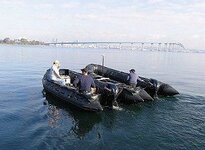davidbakhtar
Jr. Member
- Jun 28, 2007
- 26
- 0
This is a copy of my post on the Diving & Marine Forum. Any serious shallow water projects are welcome to contact me.
BakhtarRadar: A New Dimension in Non-Invasive Hydrographic Exploration and Sub-Seabed Imaging
Originally developed by Dr. Khosrow Bakhtar under the U.S. Air Force Small Business Innovative Research (SBIR) program to detect buried ordnance, BakhtarRadar is now available for civil marine applications for the first time.
BakhtarRadar’s principal marine applications are shipwreck detection and sub-seabed mapping/ volumetric imaging. It can detect metallic and non-metallic targets. In most cases, using a newly invented principle called "Forced Resonance” based on radar, BakhtarRadar can reconstruct 4-dimensional and volumetric images to better discriminate between the target and ocean floor clutter. It offers higher resolution in the MHz regime and an enhanced signal-to-noise ratio (SNR), facilitating ease of analysis and discrimination as compared to conventional systems.
Depth of penetration is up to 300 ft. of water and seabed (depending on antenna design and size of the submerged target). There are no limitations with respect to salinity, sand depth, soils or overburden.
The device is mounted on zodiacs, which are towed by the mother ship. The ship covers the search area in a zigzag pattern, then goes back over anomalies very slowly.
Seabed interrogation is triggered with a high resolution Global Positioning System (GPS), allowing transfer of the location coordinates onto any GIS system for site planning.
The technology is available through a service contract.
For more information, please contact:
David Steinman
Bakhtar Associates
PO Box 494
Bronxville, NY 10708-0494,
U. S. A.
(914) 237- 6533
email: [email protected]
BakhtarRadar: A New Dimension in Non-Invasive Hydrographic Exploration and Sub-Seabed Imaging
Originally developed by Dr. Khosrow Bakhtar under the U.S. Air Force Small Business Innovative Research (SBIR) program to detect buried ordnance, BakhtarRadar is now available for civil marine applications for the first time.
BakhtarRadar’s principal marine applications are shipwreck detection and sub-seabed mapping/ volumetric imaging. It can detect metallic and non-metallic targets. In most cases, using a newly invented principle called "Forced Resonance” based on radar, BakhtarRadar can reconstruct 4-dimensional and volumetric images to better discriminate between the target and ocean floor clutter. It offers higher resolution in the MHz regime and an enhanced signal-to-noise ratio (SNR), facilitating ease of analysis and discrimination as compared to conventional systems.
Depth of penetration is up to 300 ft. of water and seabed (depending on antenna design and size of the submerged target). There are no limitations with respect to salinity, sand depth, soils or overburden.
The device is mounted on zodiacs, which are towed by the mother ship. The ship covers the search area in a zigzag pattern, then goes back over anomalies very slowly.
Seabed interrogation is triggered with a high resolution Global Positioning System (GPS), allowing transfer of the location coordinates onto any GIS system for site planning.
The technology is available through a service contract.
For more information, please contact:
David Steinman
Bakhtar Associates
PO Box 494
Bronxville, NY 10708-0494,
U. S. A.
(914) 237- 6533
email: [email protected]









